Gas Leak Location Detection Based on Data Fusion with Time Difference of Arrival and Energy Decay Using an Ultrasonic Sensor Array
Abstract
:1. Introduction
2. Principles of Ultrasonic Leak Detection
2.1. Generation of Ultrasonic Waves
2.2. Decay Characteristics of Ultrasonic Waves
3. Single Algorithms to Be Fused
3.1. TDOA Location Algorithm
3.2. ED Location Algorithm
4. Data Fusion Location Algorithm
5. Results and Discussion
5.1. Design of the Sensor Array
5.2. Design of the Experimental Device
5.3. Experimental Results and Discussion
6. Conclusions
Author Contributions
Funding
Conflicts of Interest
References
- Murvay, P.S.; Silea, I.A. Survey on gas leak detection and localization techniques. J. Loss Prev. Process Ind. 2012, 25, 966–973. [Google Scholar] [CrossRef]
- Colombo, A.F.; Karney, B.W. Energy and Costs of Leaky Pipes: Toward Comprehensive Picture. J. Water Resour. Plan. Manag. 2002, 128, 441–450. [Google Scholar] [CrossRef]
- Almandoz, J.; Cabrera, E.; Arregui, F.; Cobacho, R. Leakage assessment through water distribution network simulation. J. Water Resour. Plan. Manag. 2005, 131, 458–466. [Google Scholar] [CrossRef]
- Fu, Q.; Wan, H.; Qiu, F. Pipeline leak detection based on fiber optic early-warning system. Procedia Eng. 2010, 7, 88–93. [Google Scholar] [CrossRef]
- Farooqui, M.A.S.Z.; Al-reyahi, A.S.; Nasr, K.K. Application of ultrasonic technology for well leak detection. Int. Petrol. Technol. Conf. 2007, 2, 1348–1352. [Google Scholar] [CrossRef]
- Fukushige, S.; Akahoshi, Y.; Koura, T.; Harada, S. Development of perforation hole detection system for space debris impact. Int. J. Impact Eng. 2006, 33, 273–284. [Google Scholar] [CrossRef]
- Lemon, D.K.; Friesel, M.A.; Griffin, J.W.; Skorpik, J.R.; Shepard, C.L.; Antoniak, Z.I.; Kurtz, R.J. Technology Evaluation for Space Station Atmospheric Leakage; Pacific Northwest Lab.: Richland, WA, USA, 1990. [Google Scholar]
- Asgari, H.R.; Maghrebi, M.F. Application of nodal pressure measurements in leak detection. Flow Meas. Instrum. 2016, 50, 128–134. [Google Scholar] [CrossRef]
- Lambrecht, A.; Maier, E.; Pernau, H.F.; Strahl, T.; Herbst, J. Gas leak detection by dilution of atmospheric oxygen. Sensors 2017, 17, 2804. [Google Scholar] [CrossRef] [PubMed]
- Kroll, A.; Baetz, W.; Peretzki, D. On autonomous detection of pressured air and gas leaks using passive Ir-Thermography for mobile robot application. In Proceedings of the IEEE International Conference on Robotics and Automation, Kobe, Japan, 12–17 May 2009; pp. 921–926. [Google Scholar]
- Dongying, W.; Fengyang, Z.; Tao, W. The ultrasonic characteristics study of weak gas leakage. In Proceedings of the 2015 International Conference on Fluid Power and Mechatronics (FPM), Harbin, China, 5–7 August 2015; pp. 681–685. [Google Scholar]
- Brandstein, M.S. A Framework for Speech Source Localization Using Aensor Arrays. Ph.D. Thesis, Brown University, Providence, RI, USA, May 1995. [Google Scholar]
- Brandstein, M.S.; Silverman, H.F. A practical methodology for speech source localization with microphone arrays. Comput. Speech Lang. 1997, 11, 91–126. [Google Scholar] [CrossRef] [Green Version]
- Reed, C.W.; Hudson, R.; Yao, K. Direct joint source localization and propagation speed estimation. In Proceedings of the 1999 IEEE International Conference on Acoustics, Speech, and Signal Processing, Phoenix, AZ, USA, 15–19 March 1999; Volume 3, pp. 1169–1172. [Google Scholar] [CrossRef]
- Tao, W.; Dongying, W.; Yu, P.; Wei, F. Gas leak localization and detection method based on a multi-point ultrasonic sensor array with TDOA algorithm. Meas. Sci. Technol. 2015, 26, 095002. [Google Scholar] [CrossRef]
- Bolotina, I.; Borikov, V.; Ivanova, V.; Mertins, K.; Uchaikin, S. Application of phased antenna arrays for pipeline leak detection. J. Petrol. Sci. Eng. 2018, 161, 497–505. [Google Scholar] [CrossRef]
- Tao, W.; Xiaoran, W.; Bo, W.; Wei, F. Gas leak location method based on annular ultrasonic sensor array. In Proceedings of the 2018 IEEE International Instrumentation and Measurement Technology Conference (I2MTC), Houston, TX, USA, 14–17 May 2018. [Google Scholar]
- Wendeberg, J.; Schindelhauer, C. Polynomial-time approximation algorithms for anchor-free TDOA localization. Theor. Comput. Sci. 2014, 553, 27–36. [Google Scholar] [CrossRef]
- Bian, X.; Li, Y.; Feng, H.; Wang, J.; Qi, L.; Jin, S. A Location Method Using Sensor Arrays for Continuous Gas Leakage in Integrally Stiffened Plates Based on the Acoustic Characteristics of the Stiffener. Sensors 2015, 15, 24644–24661. [Google Scholar] [CrossRef] [PubMed] [Green Version]
- Lighthill, J. BOOK REVIEW: Waves in Fluids. Meas. Sci. Technol. 2002, 13, 1501. [Google Scholar] [CrossRef]
- Tao, W.; Yu, P.; Huiheng, X.; Wei, F. Detection of small gas leaks based on neural networks and D-S evidential theory using ultrasonics. Insight-Non-Destruct. Test. Cond. Monit. 2014, 56, 189–194. [Google Scholar] [CrossRef]
- Dayou, M.; Peizi, L.; Genhua, D.; Hongyu, W. Pinhole noise and pinhole muffler. Chin. Sci. 1977, 20, 445–455. [Google Scholar]
- Holland, S.D.; Roberts, R.; Chimenti, D.E.; Song, J.H. An ultrasonic array sensor for spacecraft leak direction finding. Ultrasonics 2006, 45, 121–126. [Google Scholar] [CrossRef] [PubMed]
- Holland, S.D.; Roberts, R.; Chimenti, D.E.; Strei, M. Leak detection in spacecraft using structure-borne noise with distributed sensors. Appl. Phys. Lett. 2005, 86, 174105. [Google Scholar] [CrossRef] [Green Version]
- Lombard, A.; Zheng, Y.; Buchner, H.; Kellermann, W. TDOA Estimation for Multiple Sound Sources in Noisy and Reverberant Environments Using Broadband Independent Component Analysis. IEEE Trans. Audio Speech Lang. Process. 2011, 19, 1490–1503. [Google Scholar] [CrossRef]
- Garcia-Hallo, I.; Lemaire, D.; Raveu, N.; Peres, G. TDOA measurement for P-Static source location on aircraft. In Proceedings of the 2016 IEEE International Symposium on Electromagnetic Compatibility (EMC), Ottawa, ON, Canada, 25–29 July 2016. [Google Scholar]
- Chu, Y. An Improved Source Localization Algorithm Based on Newton Iterative. J. Inf. Comput. Sci. 2015, 12, 5145–5152. [Google Scholar] [CrossRef]
- Ismailova, D.; Lu, W.-S. Improved least-squares methods for source localization: An iterative Re-weighting approach. In Proceedings of the 2015 IEEE International Conference on Digital Signal Processing (DSP), Singapore, 21–24 July 2015. [Google Scholar]
- Schau, H.C.; Robinson, A.Z. Passive source localization with intersecting spherical surfaces from time delay estimates. J. Acoust. Soc. Am. 1985, 77. [Google Scholar] [CrossRef]
- Willner, D.; Chang, C.; Dunn, K. Kalman filter algorithms for a multi-sensor system. In Proceedings of the 1976 IEEE Conference on Decision and Control Including the 15th Symposium on Adaptive Processes, Orlando, FL, USA, 1–3 December 1976. [Google Scholar]
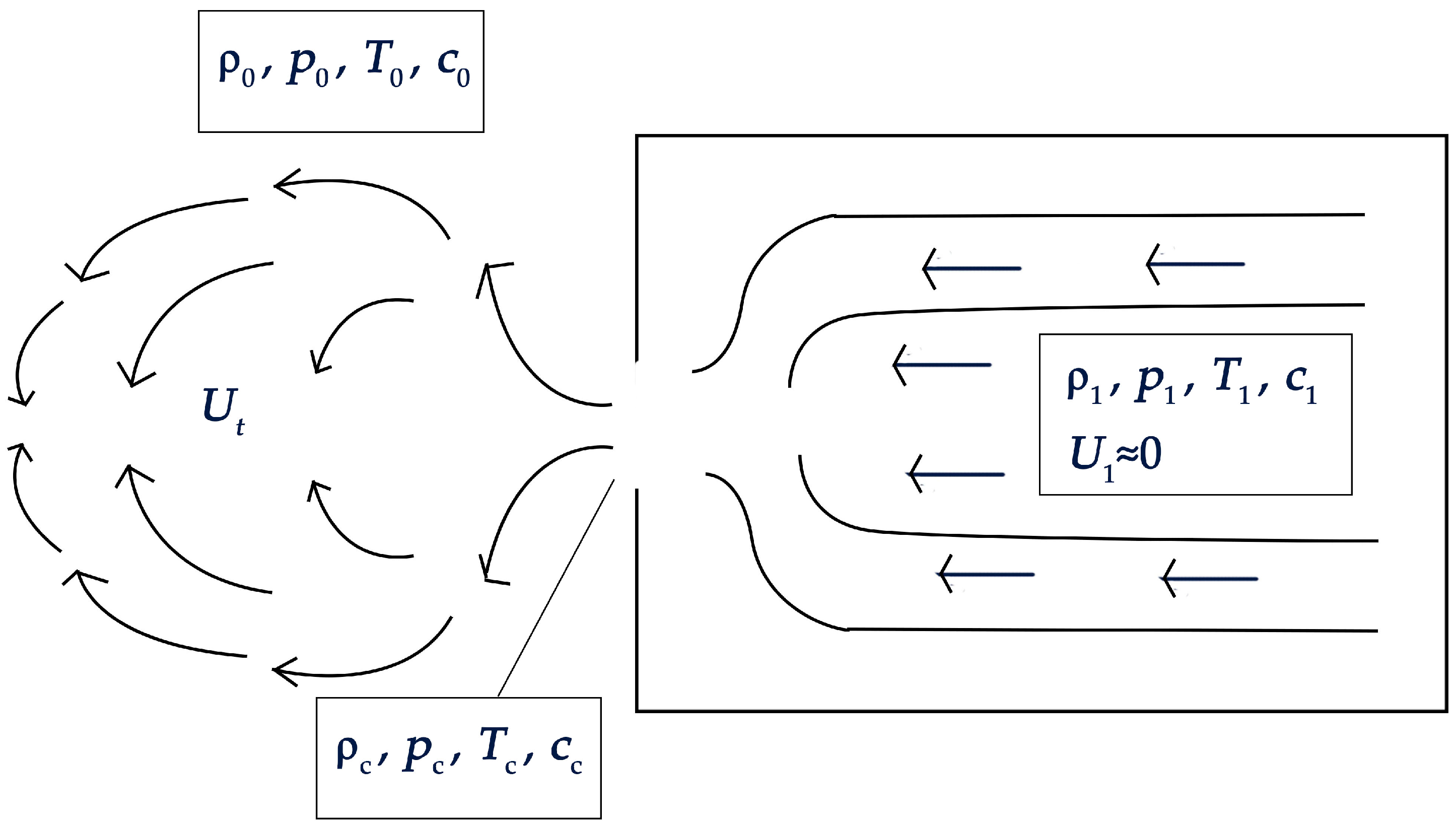
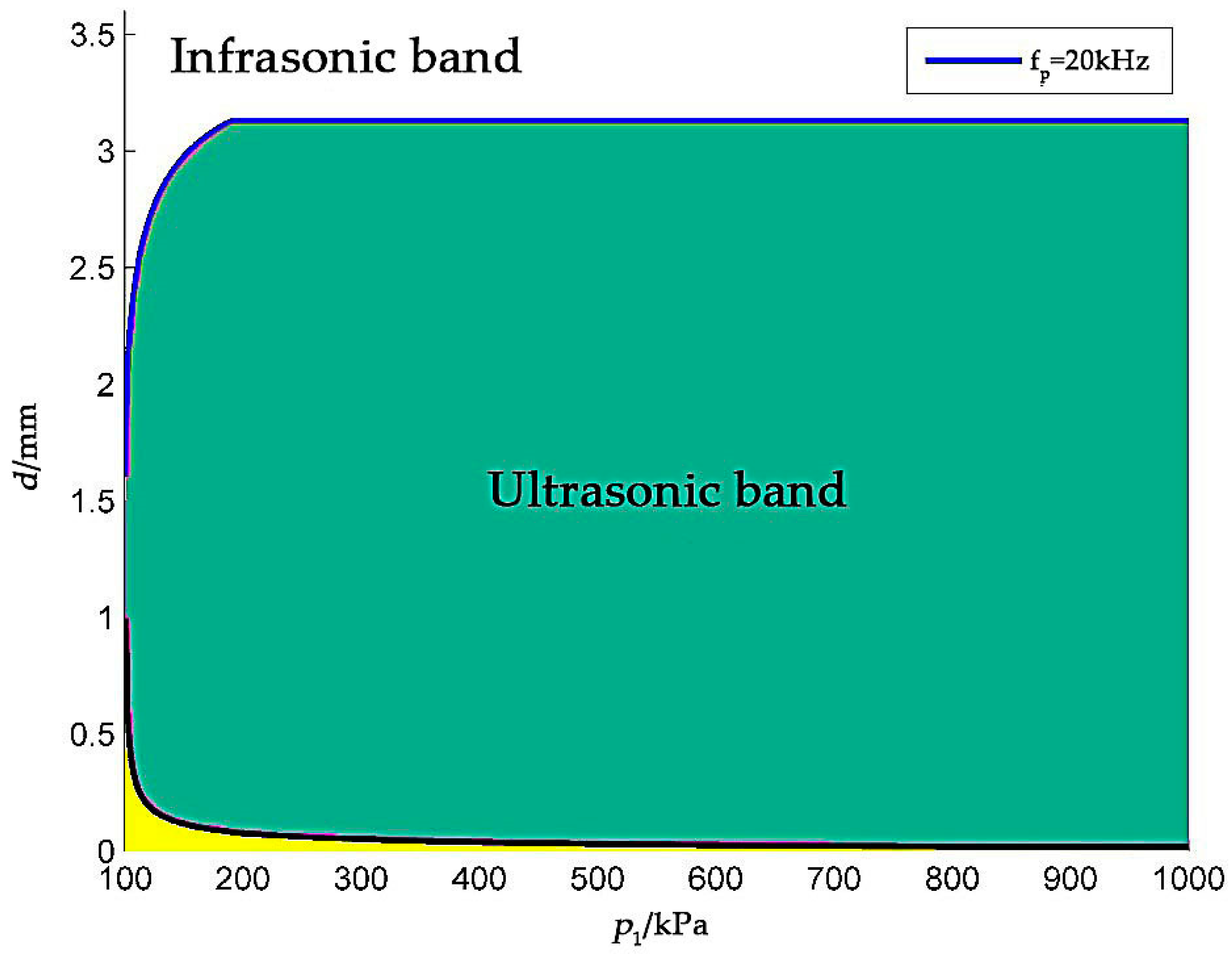
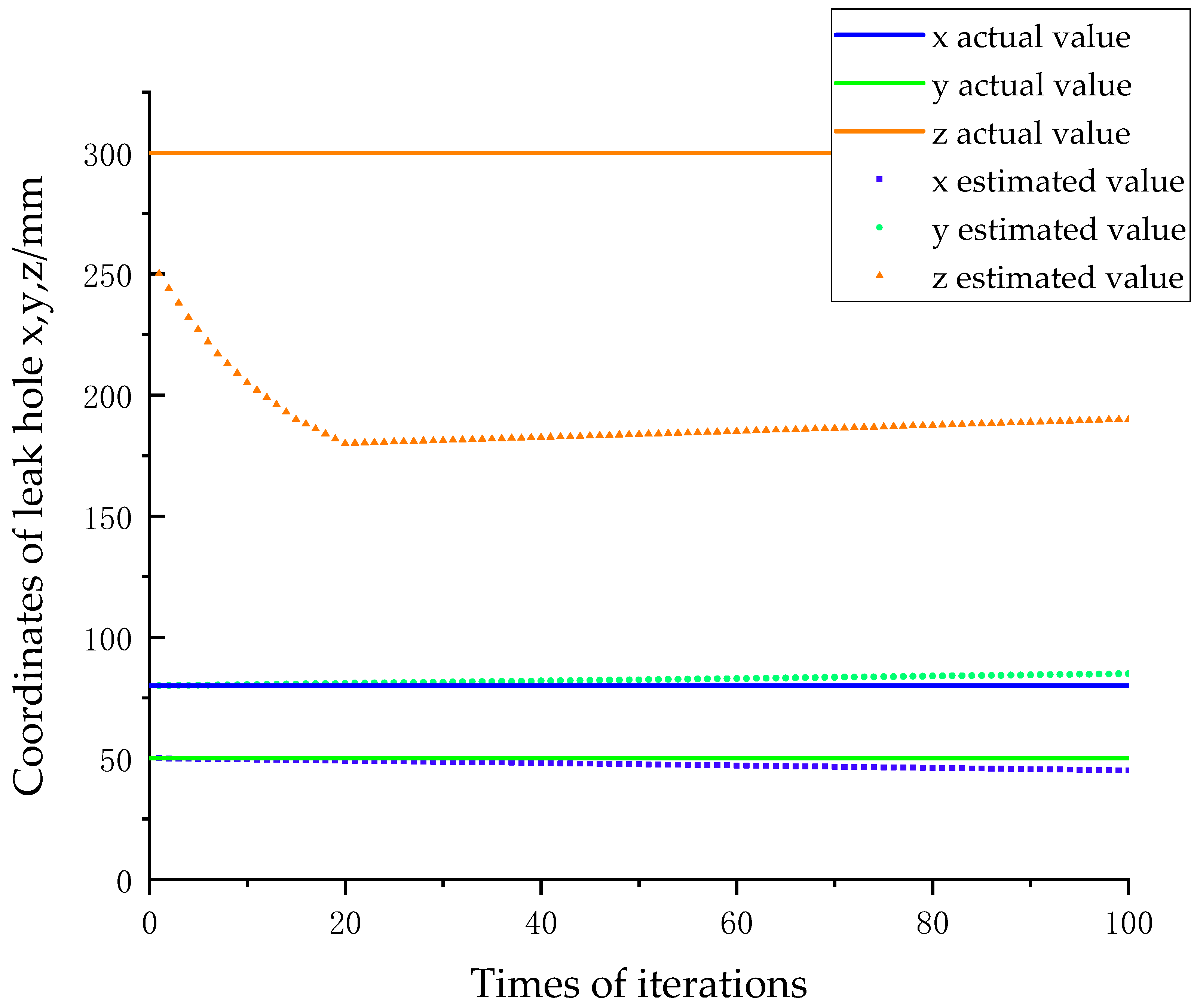
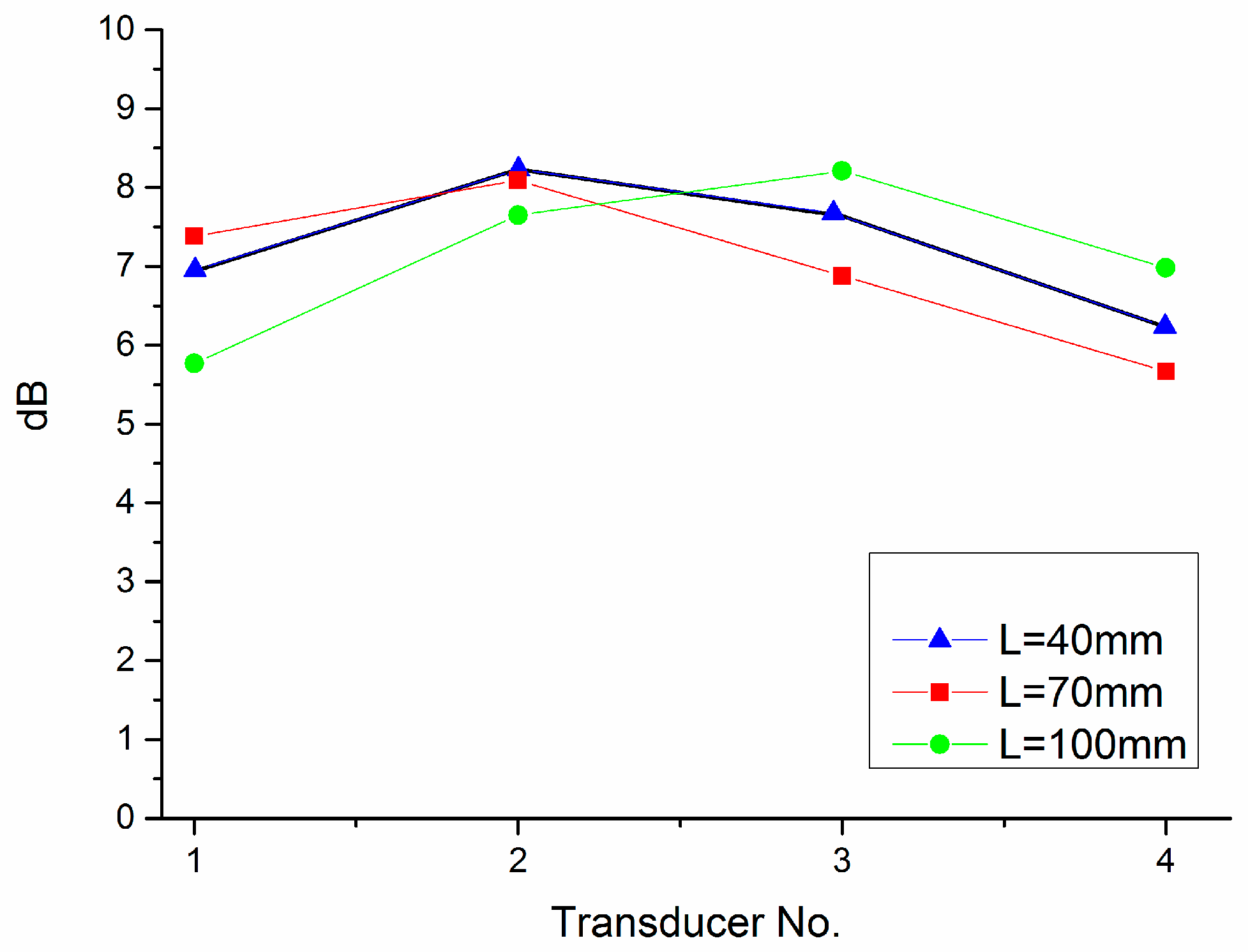
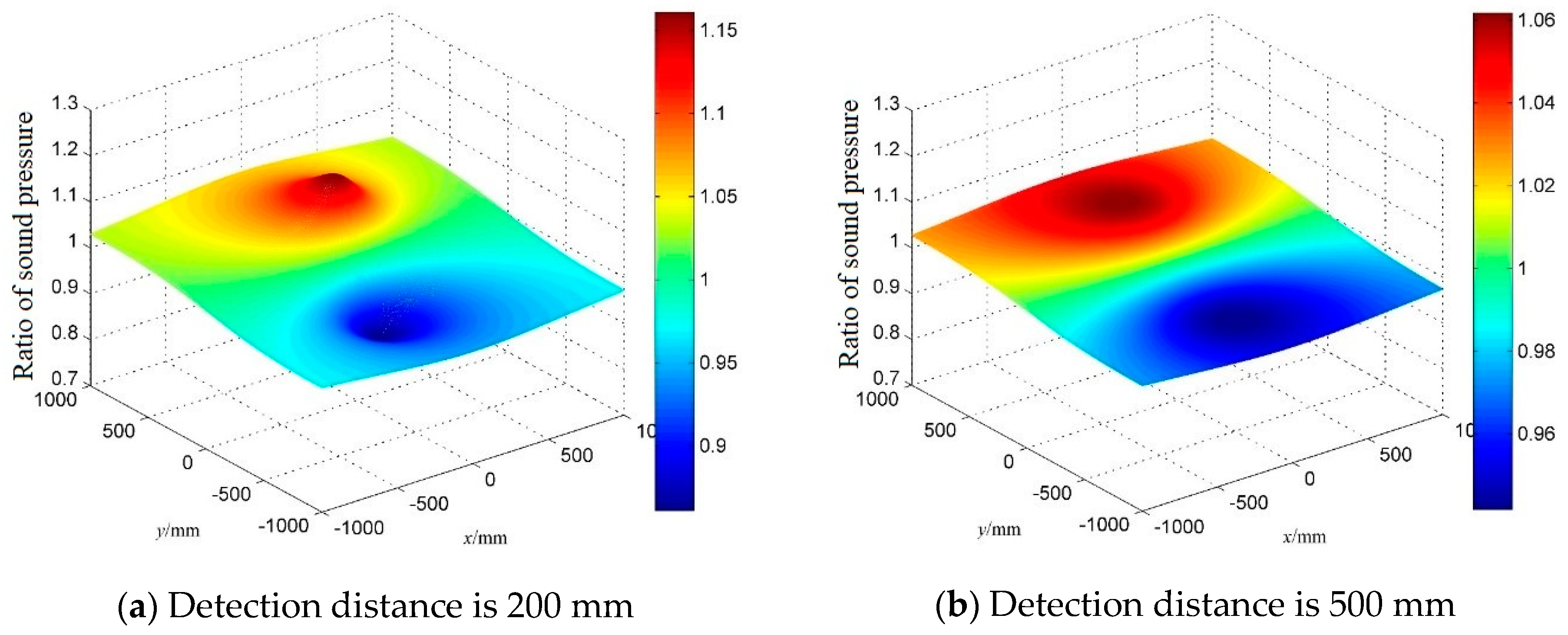

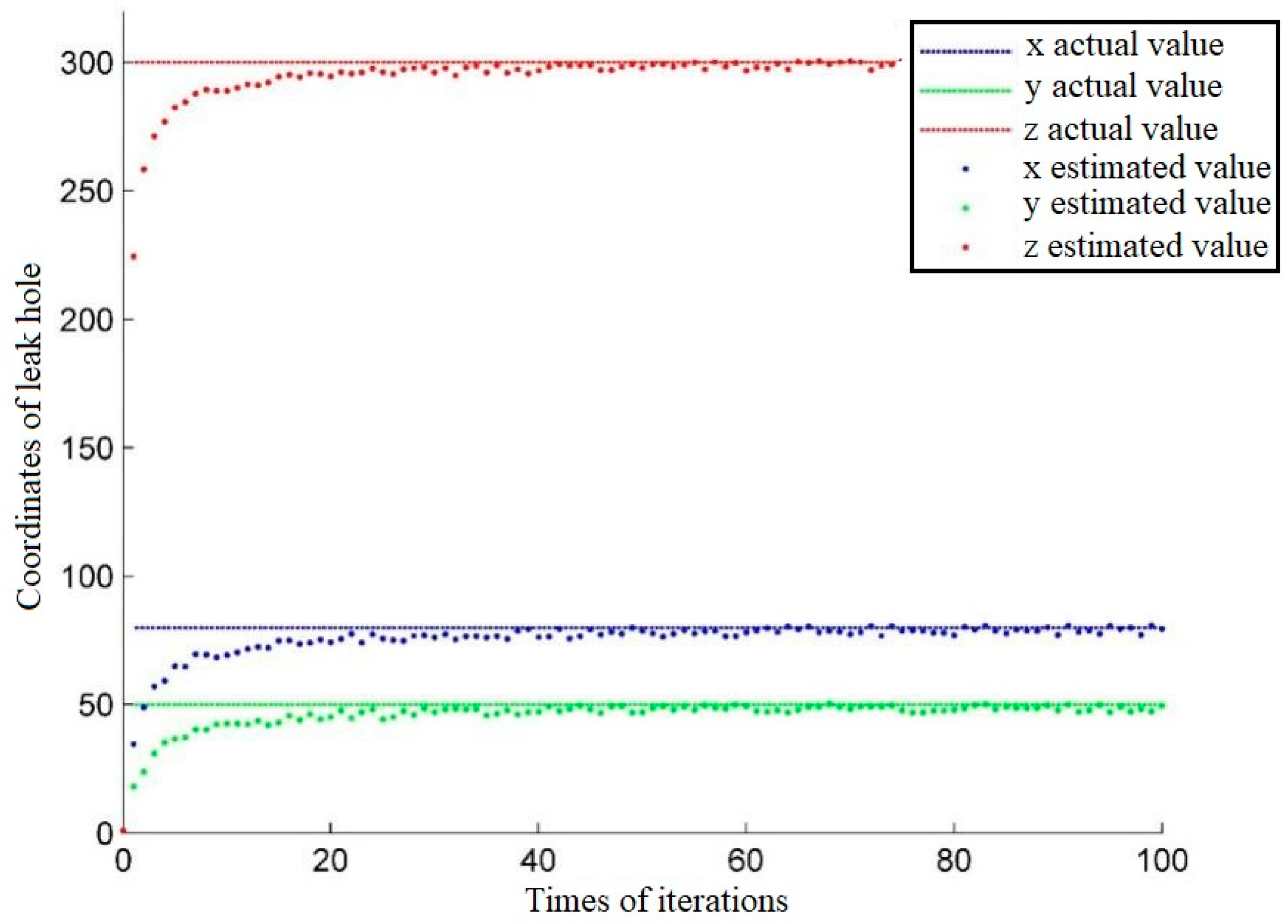
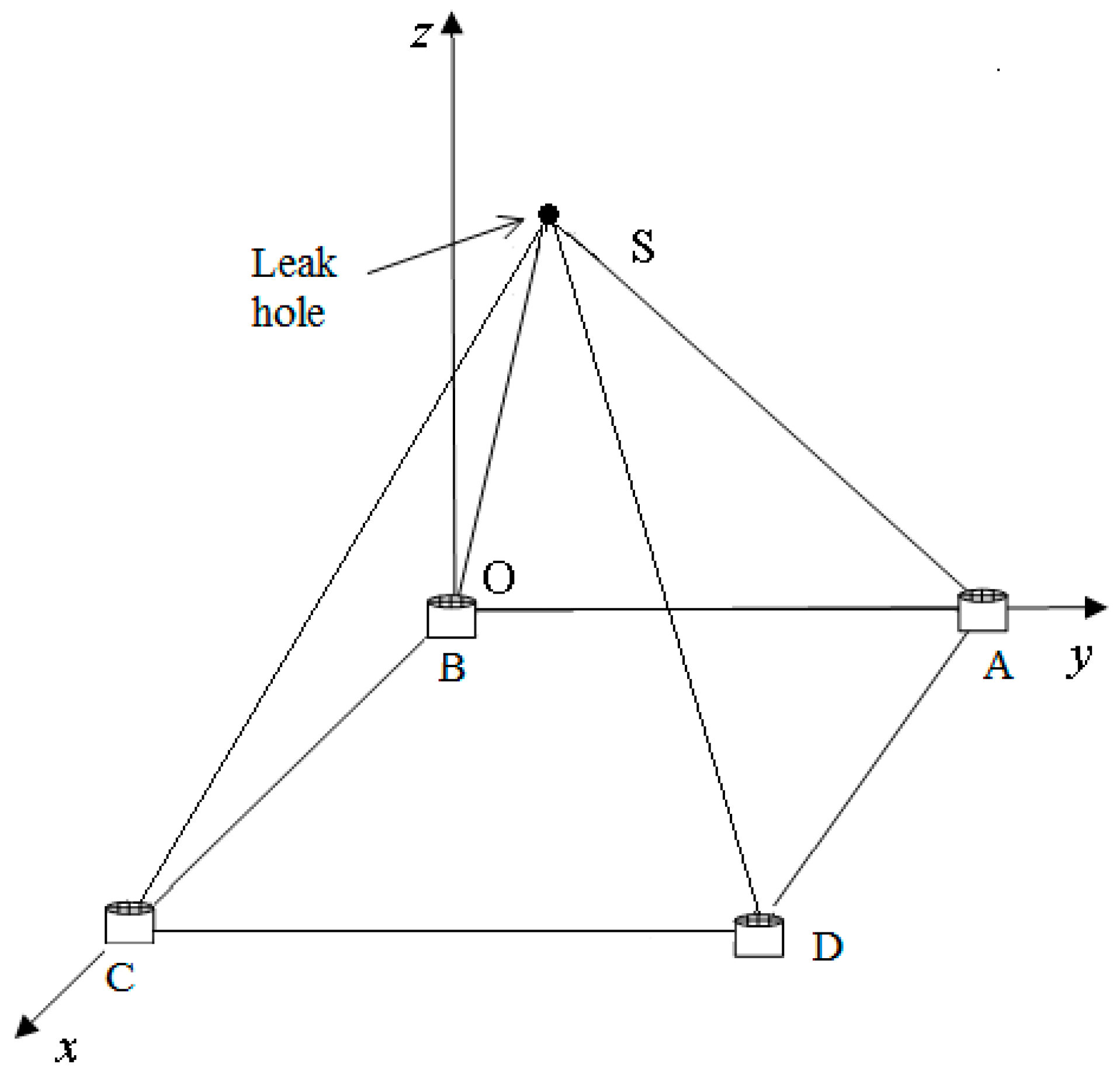
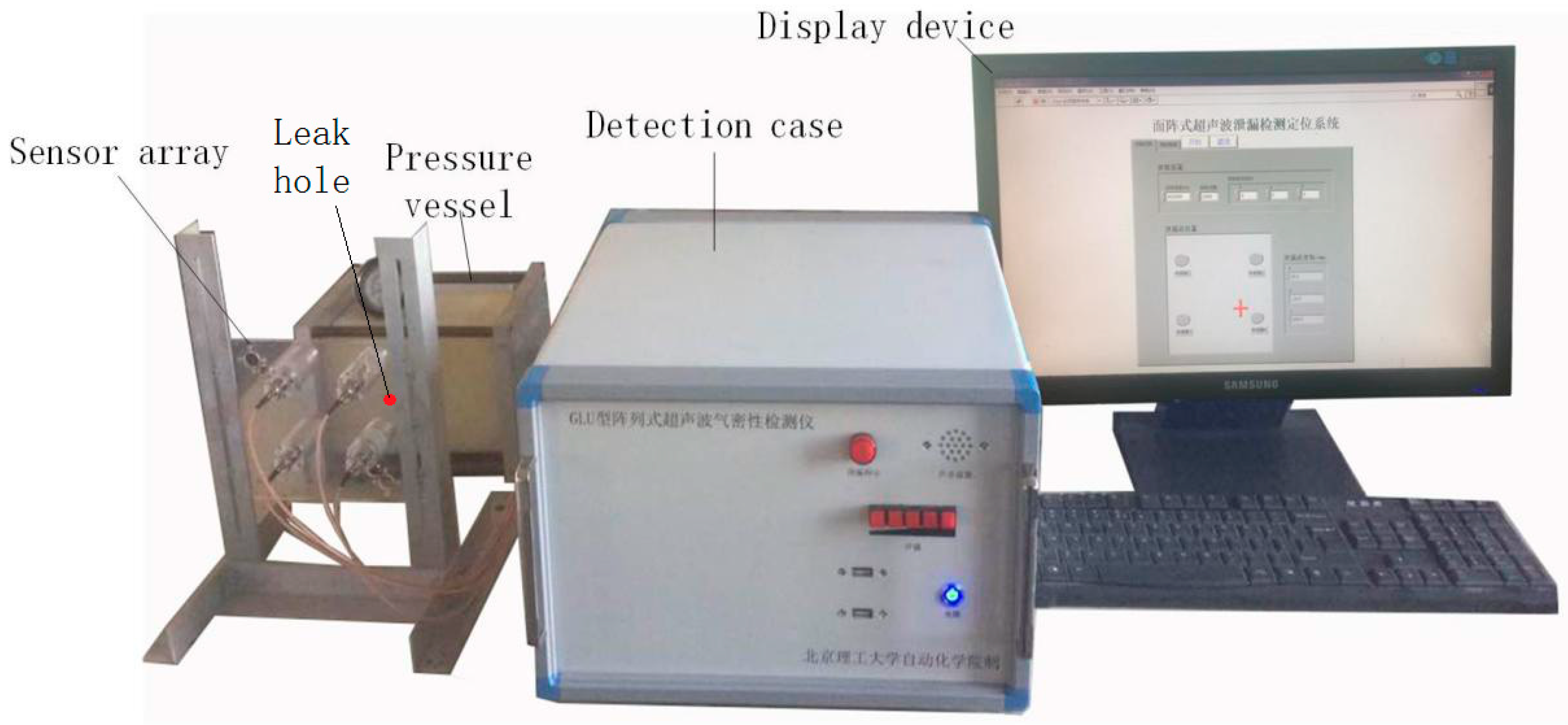
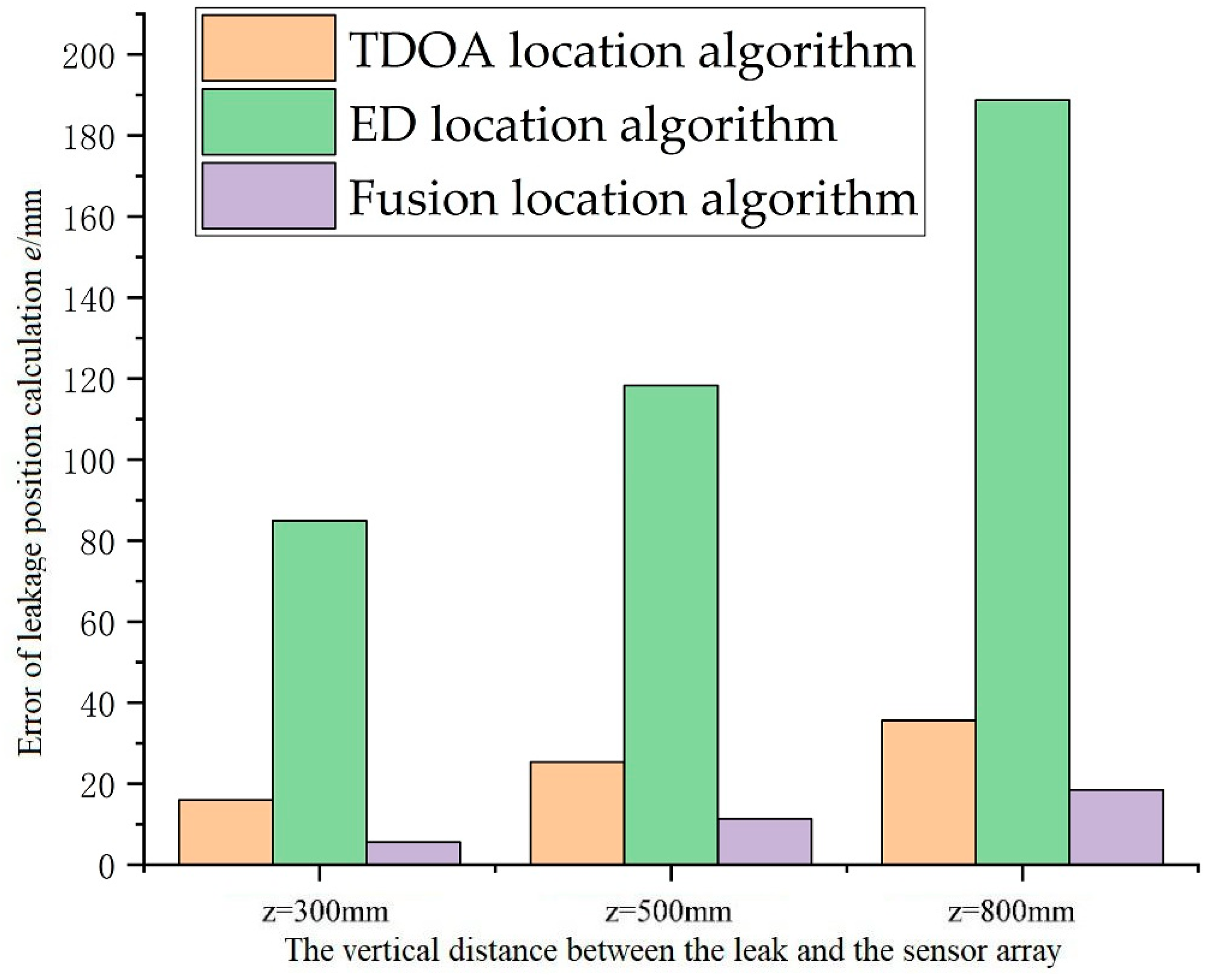
| Methods | Differential pressure methods | Mass spectrometry methods | Infrared thermal imaging methods | Ultrasonic methods |
| Principle | Pressure changes in containers | Tracking detection of leakage by tracer gas | Thermal imaging and infrared image processing | Ultrasonic waves produced by leakage |
| Advantages | Low manufacturing costs, simple principle and device | Fast, intuitive and can measure the size of the leak hole directly | High sensitivity, safe operation and fast response | Convenient operation, high sensitivity, low manufacturing costs and accurate positioning |
| Defects | Low accuracy, complicated operation, susceptible to environmental noise | High manufacturing costs, sensitivity is reduced when the pressure in the measured container is variable | High manufacturing costs, susceptible to environmental noise | Susceptible to environmental noise, hard to measure the size of the leak hole |
| Rated frequency | 40 kHz |
| Receiving sensitivity | −46 dB (0 dB = 1 V/Pa) |
| Bandwidth | 6 kHz (−54 dB) |
| Directivity | 50 deg |
| Range | 0.2~6 m |
| Resolution | 9 mm |
| Leak Positions | S1 | S2 | S3 | S4 | S5 | S6 | S7 | S8 | S9 | |
|---|---|---|---|---|---|---|---|---|---|---|
| Coordinates (mm) | ||||||||||
| x | −10 | 80 | 20 | −10 | 80 | 20 | −10 | 80 | 20 | |
| y | 70 | 50 | −20 | 70 | 50 | −20 | 70 | 50 | −20 | |
| z | 300 | 300 | 300 | 500 | 500 | 500 | 800 | 800 | 800 | |
| Leak Positions | S1 | S2 | S3 | S4 | S5 | S6 | S7 | S8 | S9 | |
|---|---|---|---|---|---|---|---|---|---|---|
| Results (mm) | x | −15.4 | 72.1 | 28.9 | −0.4 | 30.2 | −29.3 | 30.2 | 35.6 | 35.6 |
| y | 65.2 | 65.7 | −14.5 | 87.9 | 14.1 | 42.6 | 38.6 | −5.7 | −5.7 | |
| z | 309.7 | 287.4 | 290.5 | 479.2 | 165.3 | 278.4 | 376.3 | 827.2 | 827.2 | |
| Absolute errors (mm) | 12.10 | 21.63 | 14.13 | 29.07 | 30.28 | 16.64 | 35.68 | 36.77 | 34.46 | |
| Leak Positions | S1 | S2 | S3 | S4 | S5 | S6 | S7 | S8 | S9 | |
|---|---|---|---|---|---|---|---|---|---|---|
| Results (mm) | x | 10.1 | 110.3 | 28.9 | −47.4 | 30.2 | 67.2 | −74.3 | 123.0 | 53.2 |
| y | 30.7 | 78.5 | −14.5 | 108.3 | 11.3 | 45.8 | 6.2 | 93.3 | 48.4 | |
| z | 370.4 | 357.7 | 290.5 | 411.2 | 598.4 | 607.3 | 606.8 | 643.6 | 631.5 | |
| Absolute errors (mm) | 83.09 | 71.13 | 100.60 | 103.69 | 116.88 | 134.43 | 213.38 | 167.88 | 184.86 | |
| Leak Positions | S1 | S2 | S3 | S4 | S5 | S6 | S7 | S8 | S9 | |
|---|---|---|---|---|---|---|---|---|---|---|
| Results (mm) | x | −12.1 | 82.9 | 23.6 | −13.3 | 74.7 | 26.6 | −15.6 | 87.0 | 24.5 |
| y | 68.5 | 53.2 | −17.7 | 74.9 | 44.5 | −23.9 | 65.3 | 56.5 | −17.3 | |
| z | 305.8 | 298.9 | 295.8 | 511.5 | 492.2 | 508.7 | 817.8 | 784.6 | 818.1 | |
| Absolute errors (mm) | 6.35 | 4.46 | 5.99 | 13.01 | 10.92 | 10.12 | 19.24 | 17.27 | 18.85 | |
© 2018 by the authors. Licensee MDPI, Basel, Switzerland. This article is an open access article distributed under the terms and conditions of the Creative Commons Attribution (CC BY) license (http://creativecommons.org/licenses/by/4.0/).
Share and Cite
Wang, T.; Wang, X.; Hong, M. Gas Leak Location Detection Based on Data Fusion with Time Difference of Arrival and Energy Decay Using an Ultrasonic Sensor Array. Sensors 2018, 18, 2985. https://doi.org/10.3390/s18092985
Wang T, Wang X, Hong M. Gas Leak Location Detection Based on Data Fusion with Time Difference of Arrival and Energy Decay Using an Ultrasonic Sensor Array. Sensors. 2018; 18(9):2985. https://doi.org/10.3390/s18092985
Chicago/Turabian StyleWang, Tao, Xiaoran Wang, and Mingyu Hong. 2018. "Gas Leak Location Detection Based on Data Fusion with Time Difference of Arrival and Energy Decay Using an Ultrasonic Sensor Array" Sensors 18, no. 9: 2985. https://doi.org/10.3390/s18092985





